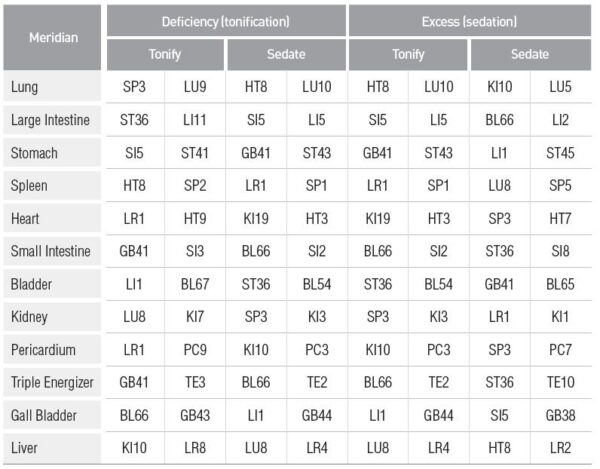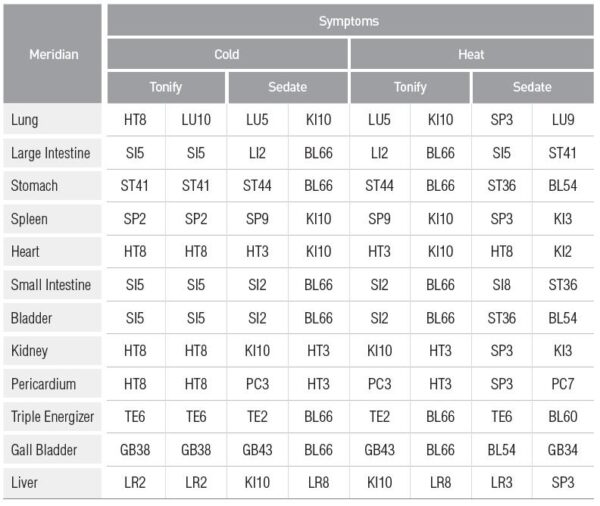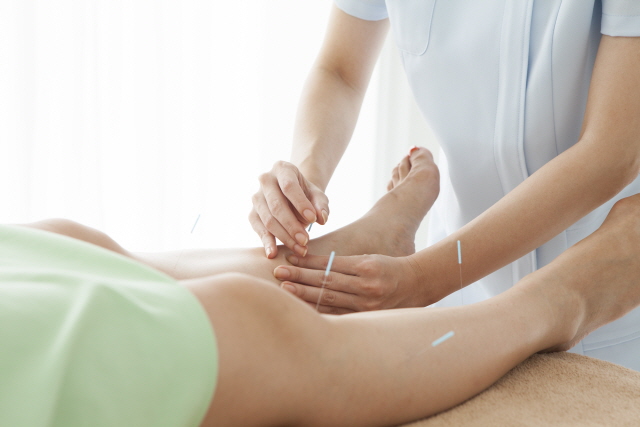Written by
- Sanghoon Lee, KMD, MPH, PhD, DiplAc, LAc Professor, Department of Acupuncture and Moxibustion, College of Korean Medicine Kyunghee university
- Dongwoo Nam, KMD, PhD Assistant Professor, Department of Acupuncture and Moxibustion, College of Korean Medicine Kyunghee university
- Jeongmin Ko, KMD, Dr.Jeongmin Ko’s Korean Medicine Clinic (Inc.) All that Korean Medicine
- Hyojung Kwon, KMD, PhD (Inc.) All that Korean Medicine
- Seung Min Kathy Lee, KMD, PhD, Research Fellow Department of Acupuncture and Moxibustion, College of Korean Medicine Kyung Hee University
- Park Jun Hyeong, KMD, MS, Researcher, Department of Acupuncture and Moxibustion, College of Korean Medicine
Kyung Hee University
Published in December 2017 by Korean Society of Acupuncture & Moxibustion Society
11. Composition of Saam acupuncture prescription: Jung-gyeuk and Seung-gyeuk
Jung-gyeuk (正格) is composed of two acupuncture points that tonify and two acupuncture points that sedate. Tonify the mother by tonifying the mother point of the mother meridian, and mother point of the self meridian. Sedate the enemy by sedating the restraining point of the restraining meridian and restraining point of the self meridian. (虛則補其母 抑其官)

Seung-gyeuk (勝格) is composed of two acupuncture points that tonify and two acupuncture points that sedate. Tonify the restraining point of the self meridian and restraining Sedate the mother point of the self meridian and mother point of the mother meridian. 實者瀉其子, 補其讐

12. Composition of Saam acupuncture prescription: Han-gyeuk and Yeol-gyeuk
Han-gyeuk treats by tonifying heat and discharging cold. Therefore, fire point of self meridian and fire point of heart meridian is tonified. And water point of self meridian and water point of kidney meridian is sedated.

Yeol-gyeuk treats by tonifying cold and discharging fire. To extinguish fire and add water, water point of self meridian and water point of Kidney meridian is tonified. And fire point of self meridian and fire point of Heart meridian is sedated.

This is the theoretical composition of the Han-gyeuk and Yeol-gyeuk. Some kinds of diseases are caused by the imbalance between heat and coldness in the body and the corresponding treatments consist of using the Water and Fire points along the meridian in question and the meridians with the characteristic of Fire and Water. For a heat symptom, the Water point of the self meridian and that of the Water meridian are selected to tonify Water, as well as the Fire points of the self and Fire meridians selected to sedate Fire. For a cold symptom, the Fire points of the self and Fire meridians are selected to tonify Fire, as well as the Water point of the self meridian and that of the Water meridian selected to sedate coldness.
In the case of cold symptoms in Lung, the coldness can be balanced by both the tonification of heat and sedation of coldness. Accordingly, the Fire points, LU10 of the self meridian and HT8 of the Fire meridian, should be tonified to warm coldness. Conversely, the Water points, LU5 of the self meridian and KI10 of the Water meridian, should be repressed. The other meridians follow the same rules. The Heart and Kidney meridians share the same equation of points, the Fire points and the Water points of the two meridians.
In the case of heat symptoms in Lung, the Fire symptom can be controlled by Water, thus the Water points, LU5 of the self meridian and KI10 of the Water meridian should be tonified. Conversely, the Fire points, LI10 of the self meridian and HT8 of the Fire meridian, should be repressed. The other meridians follow the same rule.
However, in clinical practice the heat and coldness symptoms do not tally like that. Simply using Fire and Water elements sometimes does not fall into place because the heat and coldness themselves are brought about by the excess or deficiency of the complex meridians.
There are two different versions of Saam acupuncture texts, the <Jeong-jeon> and the <Yeol-gyeol>. The <Yeol-gyeol> version is more widely used, so the table consists of the points in <Yeol-gyeol>. The han-gyeuk of the Large Intestine, Heart, and Triple Energizer meridians follow the simple rule of either tonifying Water and sedating Fire elements. The rest of the meridians sedate the Earth element, because Earth controls Water, of which the characteristics is coldness. Also, sedating Earth instead of directly sedating Fire can bring about the function of Water to its greatest. Earth is son-relationship to Fire, therefore sedating Earth can also bring down the energy of Fire. Heart and Triple Energizer meridians are exceptions because they are the main meridians that move Fire. Pericardium and Small Intestine meridians are also Fire meridians, but by sedating Earth points they equal the seung-gyeuk. Large Intestine meridian is used to treat diseases caused by Damp heat and many diseases treated by this meridian is related to overwhelming heat, so the Fire point is directly sedated.
13. Pictures of each Saam acupuncture prescription
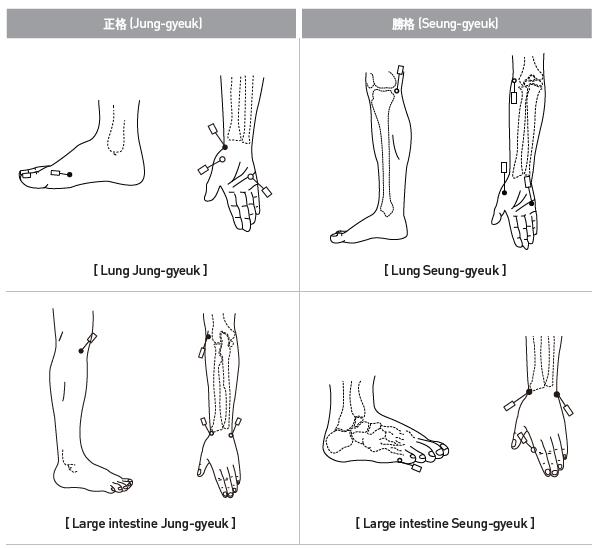
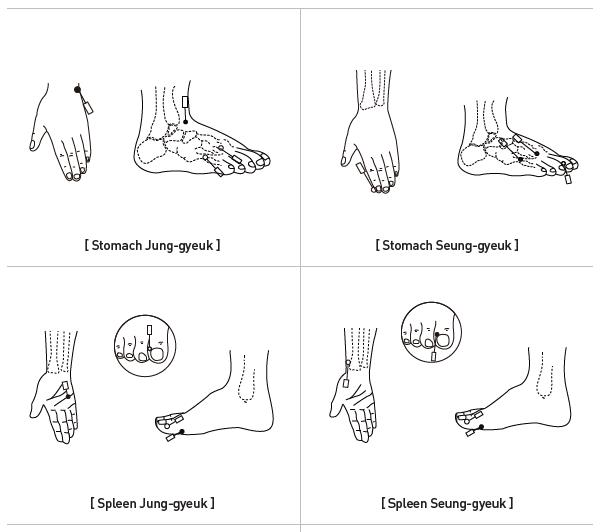
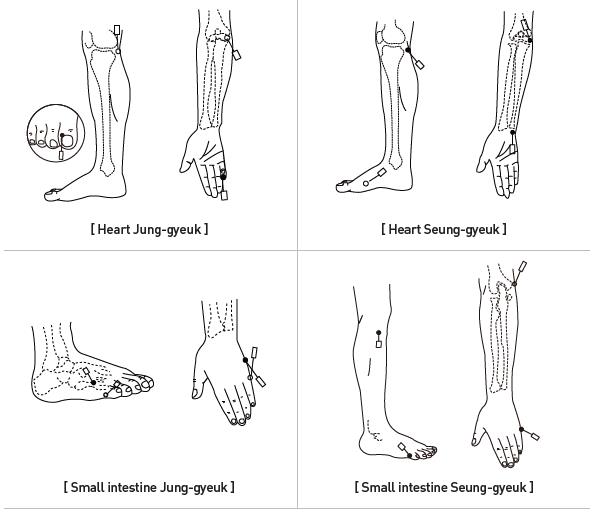
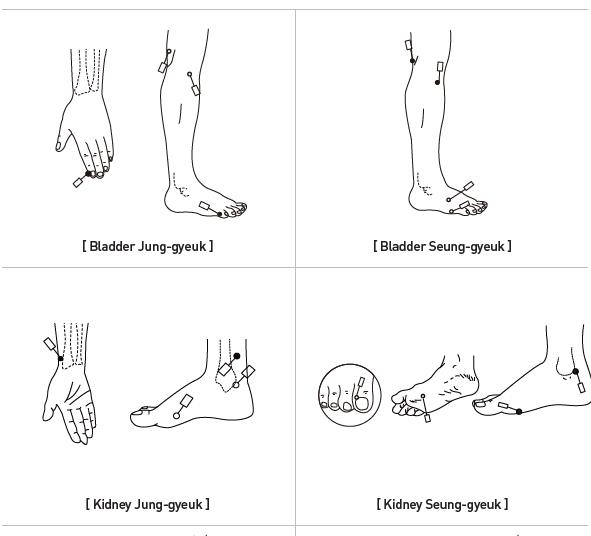
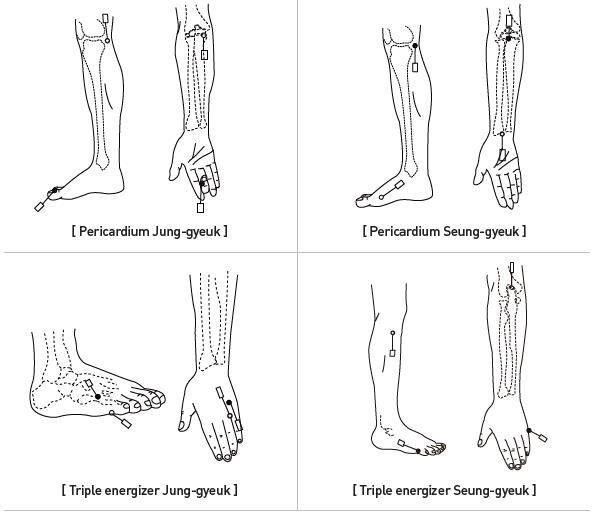
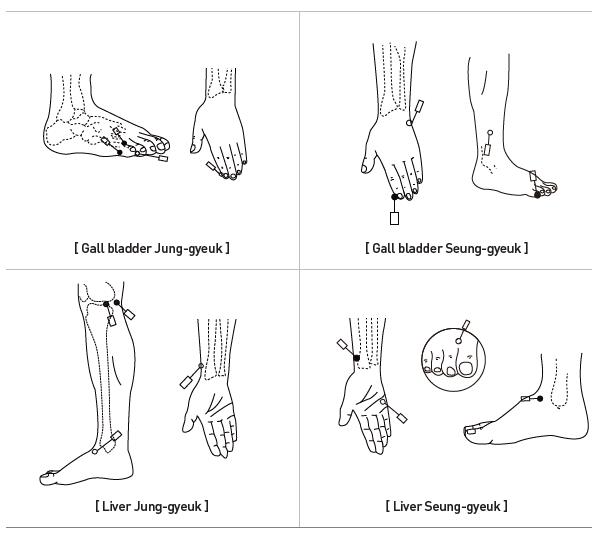
14. Manipulation in Saam acupuncture
1) thumb method
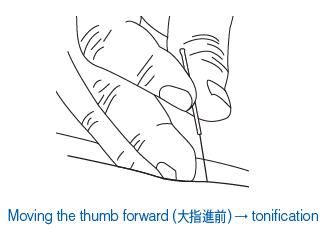 Manipulation of tonification of sedation in Saam acupuncture seems to have been affected by 『Experienctial prescriptions of acupuncture and moxibustion: 鍼灸經驗方』 written by Huh-im (許任).
Manipulation of tonification of sedation in Saam acupuncture seems to have been affected by 『Experienctial prescriptions of acupuncture and moxibustion: 鍼灸經驗方』 written by Huh-im (許任).
Manipulation of certain point in one Saam acupuncture prescription strengthens the original purpose of treatment, either tonifying or sedating. There are various techniques in manipulation.
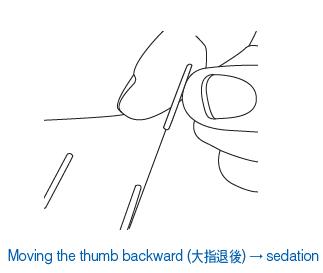 2) Breathing method (呼吸補瀉)
2) Breathing method (呼吸補瀉)
This is matching the administration of acupuncture needles to the patient’s breath. Administration upon patient’s exhaling and taking out the needle upon inhaling → tonification Administration upon patient’s inhaling and taking out the needle upon exhaling → sedation
3) Direction of the needle method (迎隨補瀉)
An identical acupuncture point may be either tonified or sedated according to the direction the needle is inserted into. Administration of acupuncture needle along the direction of the certain meridian →tonification Administration of acupuncture needle in opposite direction of the certain meridian flow → sedation
4) Nine or six method (九六補瀉)
Nine times of stimulation of the acupuncture needle →tonification
Six times of stimulation of the acupuncture needle → sedation
15. Table of Saam acupuncture
